For their actions in Afghanistan spanning more than two years, soldiers from 3rd Special Forces Group on Tuesday were presented with 68 awards.
Among them was Capt. William Eberle, who earned the Distinguished Service Cross, which is second only to the Medal of Honor. Eight other soldiers from 3rd Group received the Silver Star, the third-highest award for valor.
In all, Gen. Joseph Votel, commander of U.S. Special Operations Command, presented one DSC, eight Silver Stars, 21 Bronze Star Medals with Valor device, 16 Army Commendation Medals with Valor device, and 22 Purple Hearts during the ceremony at Fort Bragg, North Carolina.
"These warriors set the example in everything they did, and they did it in the moment that mattered the most," Votel said during the ceremony. "They acted often times without regard for their own safety because they knew the job had to be done."
Lt. Gen. Charles Cleveland, commander of U.S. Army Special Operations Command, said he was humbled by the Special Forces soldiers, who performed "magnificently" and fought "tenaciously."
"To the men we honor today, you are indeed exceptional," he said. "You've made the extraordinary commonplace, so it is that much more exceptional when we, from among this extraordinary group, identify those who merit awards for valor."
The highest award presented Tuesday was the Distinguished Service Cross. Eberle earned the award for his actions on Dec. 2, 2012.
On that day, Eberle and his detachment served as a quick-reaction force in response to an attack on Jalalabad Airfield in Nangarhar province, Afghanistan.
Enemy fighters had breached the exterior and interior gates of the base with two vehicle-borne improvised explosive devices, injuring dozens, according to the narrative accompanying Eberle's award.
When Eberle, the detachment commander, and his team arrived, they found American and Afghan forces pinned against a wall. Several of them were seriously wounded.
Eberle directed his vehicle to the breach to shield the wounded and provide effective suppressive fire. He then dismounted from his vehicle, while under direct enemy fire, to gain better situational awareness of where the enemy was located. Eberle's command and control in the initial moments allowed the injured American and Afghan troops to be evacuated safely.
Eberle then moved to a tower near the gate to get a better view of the fight. It also allowed him to engage the enemy — some of whom were just a meter away from the tower — from an elevated position.
As he fought, Eberle was "consistently exposed to enemy fire, but he continued to engage the enemy from his position in the tower, which received enemy hand grenades, rocket propelled grenades and small-arms fire," according to the narrative. Some of the enemy's grenades were air bursting on the netting of the wall and landing on the ledge of the tower, exploding right next to Eberle.
After Eberle ran out of grenades, he moved back to his vehicle to coordinate his efforts with the other advisers on the ground. As the other advisers and their Afghan counterparts re-took the tower and began to move outside the breach, Eberle and the detachment's Joint Tactical Air Controller coordinated air support for the ground forces.
Eberle is credited with saving multiple friendly lives and preventing Jalalabad Airfield from being overrun by enemy forces.
Here's a look at the eight soldiers who were recognized with the Silver Star:
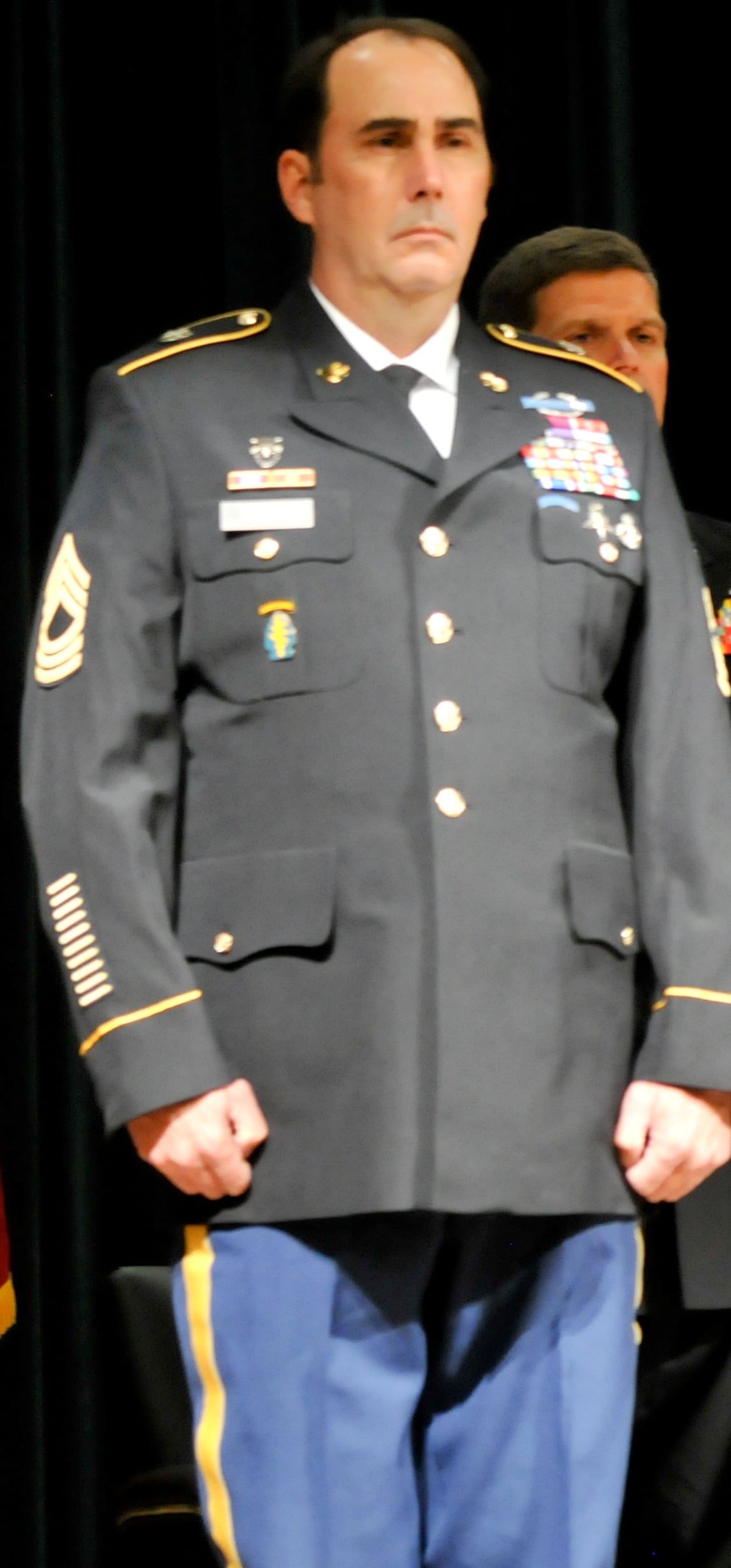
Batson
Photo Credit: 3rd Special Forces Group
• Master Sgt. Jeffrey Batson earned his Silver Star during Operation Amal Kard Sygana II in Chak Valley, a known enemy stronghold in Afghanistan's Wardak province.
On Oct. 23, 2012, Batson repeatedly braved enemy small arms, heavy machine gun, rocket-propelled grenade and sniper fire as he directed and coordinated his teammates and their Afghan counterparts to repel an attack from multiple directions. Under heavy fire, Batson Barton drew fire away from his detachment commander's position, allowing the commander to coordinate air-to-ground suppressive fires. Batson Barton also provided key observations and corrections that eventually helped suppress the attack.
Batson's Barton's actions prevented the enemy from overrunning the Americans' positions, but his actions didn't stop there.
Shortly afterward, the enemy regrouped and attacked again, pinning down all three of the Americans' blocking positions.
Batson volunteered to lead a small team to identify the enemy's firing positions and relieve some pressure on the American blocking positions.
Riding on all-terrain vehicles, Batson and his team found the enemy and tried to flank around the enemy's western-most position. Right behind him was his detachment commander leading another five-man team.
Both dismounted teams soon came under heavy enemy fire, but that didn't stop Batson and his team from moving north into "deadly accurate enemy fire" to try to positively identify the enemy's fighting positions, according to the narrative accompanying his award.
After moving more than 400 meters through open terrain, under heavy fire, Batson identified multiple enemy locations and quickly passed them up to the detachment commander to coordinate air-to-ground fires. This information enabled the JTAC to call in deadly airstrikes on the enemy.
The next day, the enemy attacked again. Batson provided covering fire to enable his commander, JTAC and three others to move to an overwatch position. He also continued to provide critical information to help the team call in air-to-ground strikes on the enemy.
When the engagement was over, Batson led 20 personnel into three overwatch positions before leading a five-man element more than 200 feet below to conduct a battle damage assessment.
The team immediately came upon a group of eight enemy fighters hiding in thick foliage. The Americans surrounded and engaged the enemy elements, some as close as five meters away, according the narrative.
At the same time, Batson continued to relay information to the JTAC, enabling attack helicopters to prevent the enemy from moving into the high ground.
When the soldiers' air support departed, the area once again rang with enemy fire.
Batson provided covering fire for his team until he was hit in the right leg by small-arms fire. The round went through his leg, fracturing his femur and severing his femoral artery, before lodging in his left leg.
Batson sought cover behind his ATV and continued to fight until he realized how much blood he was losing, according to the narrative.
Batson continued to relay last known enemy locations even while he received medical care and was moved into a medical evacuation helicopter.
At the end of the soldiers' two-day operation, the men were engaged in enemy firefights for more than 14 combined hours, and Batson was a "key factor" in the destruction of five enemy vehicles, five motorcycles, one mortar system, one enemy cave system, and the recovery of multiple enemy weapons and equipment. He also is credited with 39 enemy fighters killed, including five that he personally engaged with his own weapon, and 10 to 15 enemy fighters wounded.
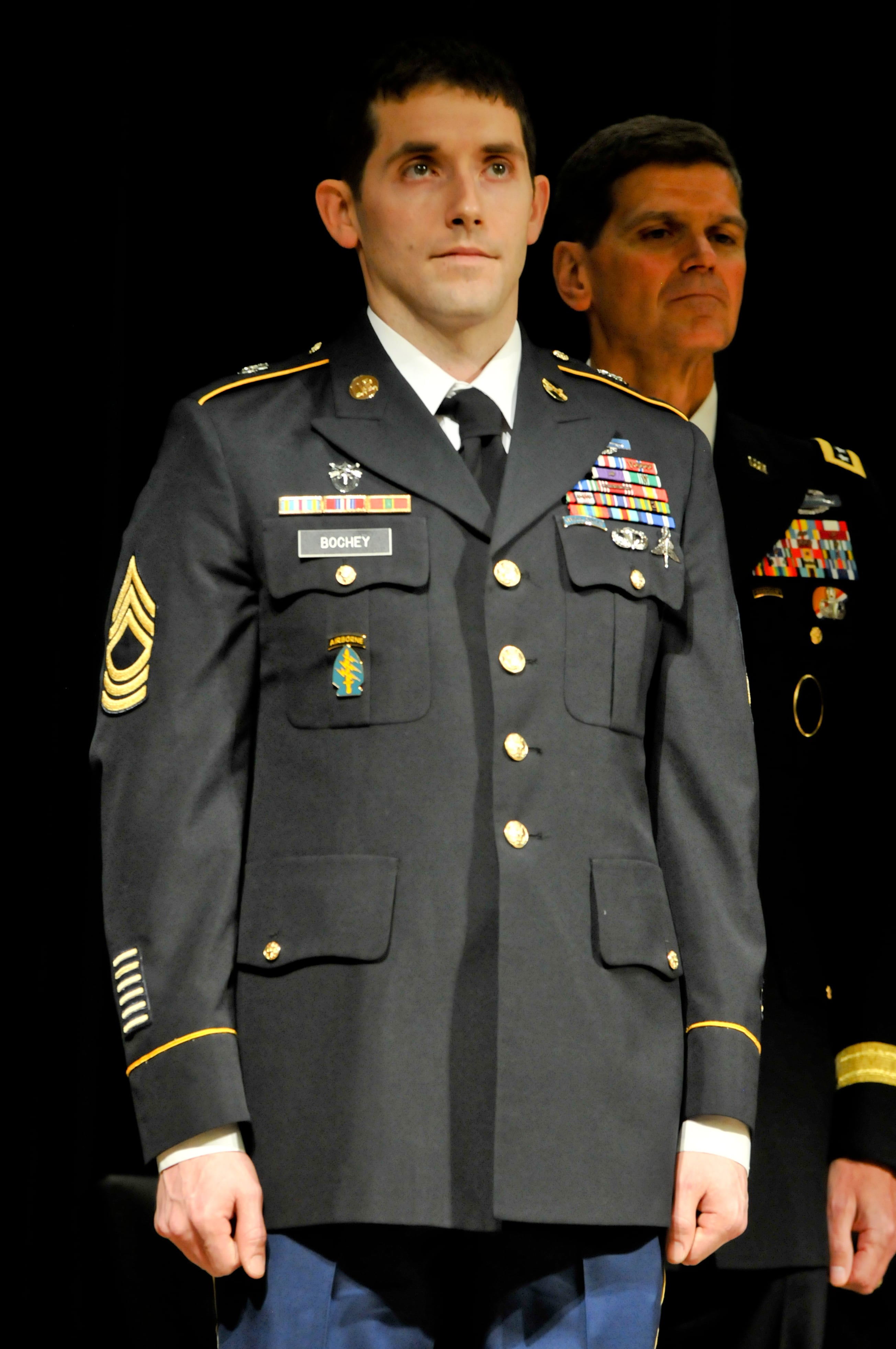
Bochey
Photo Credit: 3rd Special Forces Group
• Master Sgt. Jeffrey Bochey received the Silver Star for his actions on Jan. 17, 2014, in Kandahar, Afghanistan.
Under heavy and effective enemy fire, Bochey led a combined element of Special Forces soldiers and Afghan police officers on an assault of a fortified insurgent fighting position.
Bochey exposed himself to enemy fire multiple times as he led the element from the front, according to the narrative accompanying his award.
During the same operation, after two days of being effectively engaged by a determined enemy force, Bochey again willingly exposed himself to enemy fire as more than 50 insurgents attacked the Americans and Afghans. At least two U.S. troops and a military working dog were wounded as the friendly forces tried to withdraw to a training center.
Running low on ammunition, Bochey left the cover of his vehicle to provide "critical suppression fires, placing himself at great risk for personal harm," according to the narrative.
"Firing multiple weapon systems with great accuracy, his efforts were instrumental in stopping the reinforced and determined enemy from maintaining fire superiority and causing further casualties," according to the narrative.
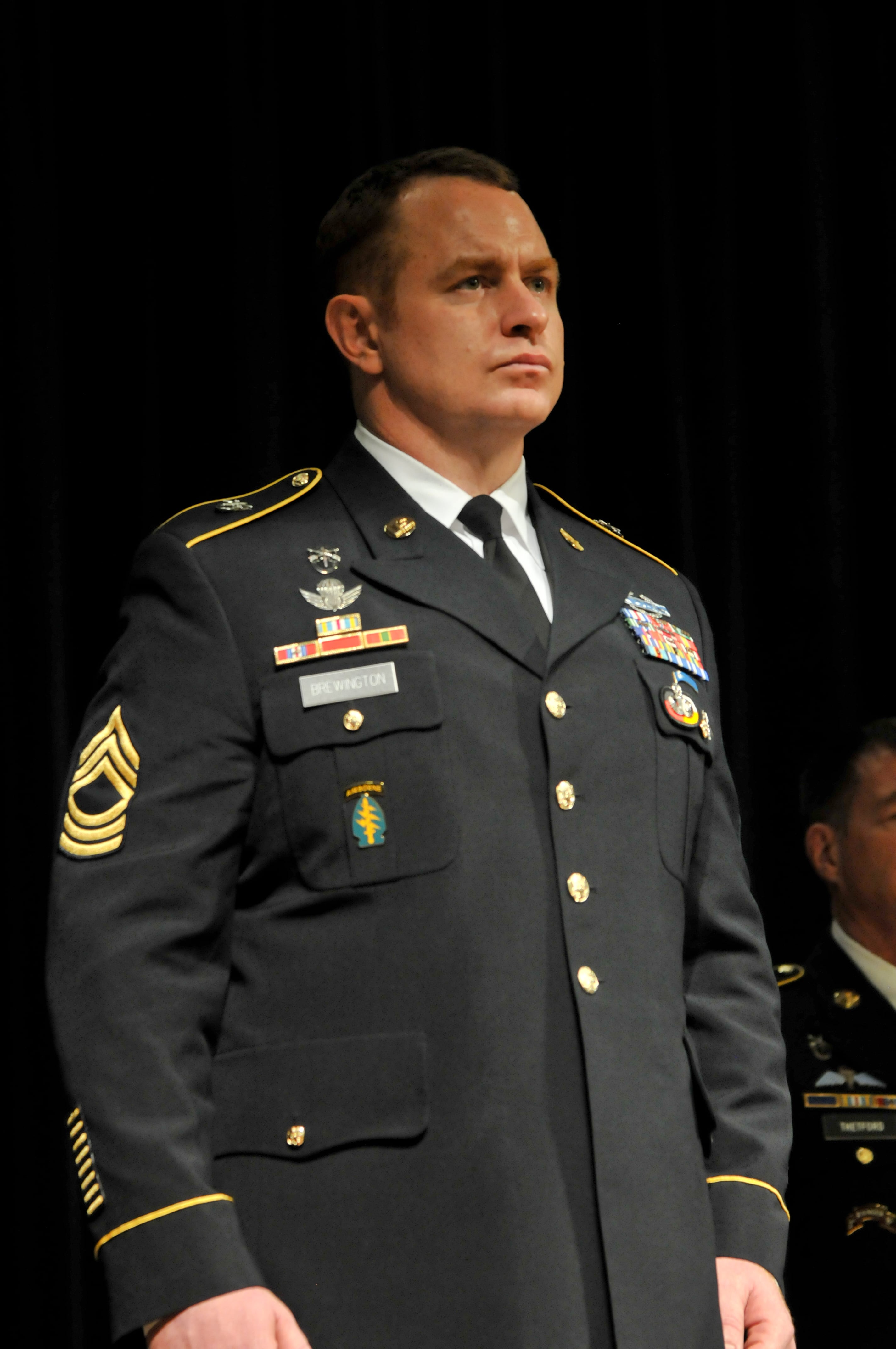
Brewington
Photo Credit: 3rd Special Forces Group
• Master Sgt. Johnie Brewington was part of a team that on April 6, 2013, was sent to extract nine American advisors and their partner force from the Sono Valley in Afghanistan's Kunar province.
The advisors and their partners were pinned down in a compound by more than 100 Taliban and foreign fighters near Bar Ghunday Village. The enemy had the compound surrounded, and they were within 200 meters of the perimeter wall, engaging the friendly force with small arms, machine guns and RPGs from elevated, fortified fighting positions, according to the narrative accompanying Brewington's Silver Star.
Once Brewington and his team arrived, they realized their vehicles would not be able to travel down the Sono Valley road, so they moved by foot over four kilometers while under heavy enemy fire.
As the soldiers moved forward, Brewington bounded from element to element, making sure his operators were in the most critical positions. Each time, Brewington was targeted and engaged by the enemy from numerous positions. And each time, Brewington passed along information about enemy positions back to his commander, enabling him to call in accurate air-to-ground strikes.
When Brewington and a teammate moved forward, again under heavy fire, to extract friendly casualties, Brewington was hit in his back armor plate by a machine-gun round, according to the narrative.
"With complete disregard for his own safety and as rounds were striking the stream bed all around him, Brewington and his teammate moved across the linear danger area and recovered [a] killed American, who had fallen into the stream," the narrative states.
Brewington's knowledge, leadership and bravery under fire is credited with saving "countless" American and Afghan lives and facilitated the extraction of a killed American and severely wounded Afghan soldier from the valley, the narrative states.
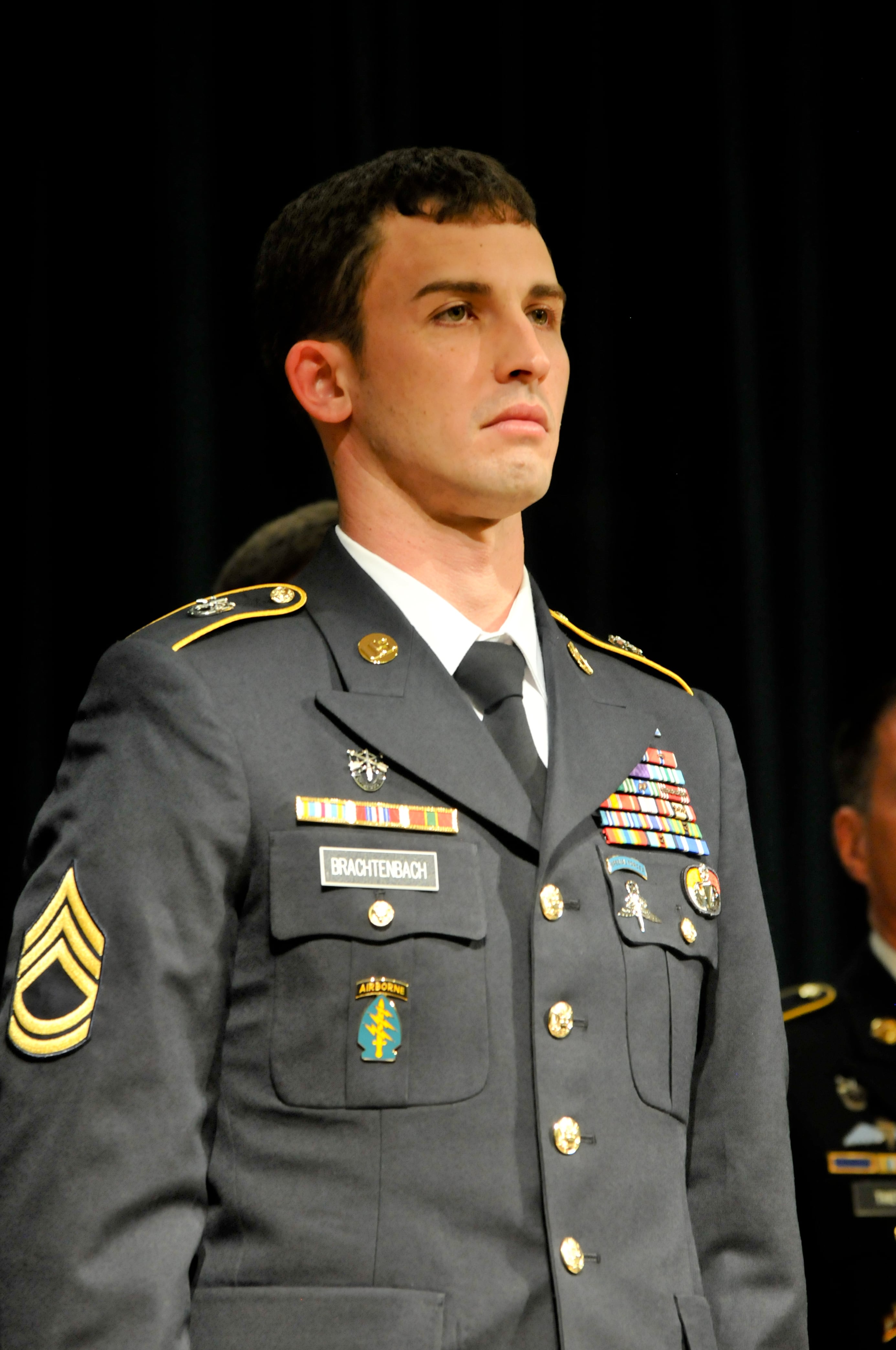
Brachtenbach
Photo Credit: 3rd Special Forces Group
• Sgt. 1st Class Clayton Brachtenbach earned his Silver Star on Jan. 17, 2014, in Afghaniya Valley in Afghanistan's Kapisa province.
Brachtenbach and his team of American and Afghan troops were sent on a reconnaissance mission in the area when the enemy opened fire.
Brachtenbach fired and maneuvered multiple times, exposing himself to enemy fire, as another friendly element advanced on the enemy, according to the narrative accompanying his award.
After that initial enemy force was "neutralized," the friendly force continued moving east along a riverbed until it came under enemy fire again, this time from at least two directions. Crawling into position, Brachtenbach killed two enemy fighters and wounded a third, allowing the rest of the force to suppress the rest of the enemy force.
The friendly force continued to move forward, coming under fire for a third time.
Brachtenbach immediately laid down suppressive fire, allowing the rest of the element to reach cover, according to the narrative accompanying his award.
While pinned down in a small ditch, Brachtenbach low-crawled under heavy fire until he was able to occupy a rooftop. He killed two enemy fighters and provided covering fire as the rest of the friendly force engaged the enemy.
As Brachtenbach and his team moved north, they again came under fire, and Brachtenbach again low-crawled to a position of advantage, covering his team as they fought the enemy.
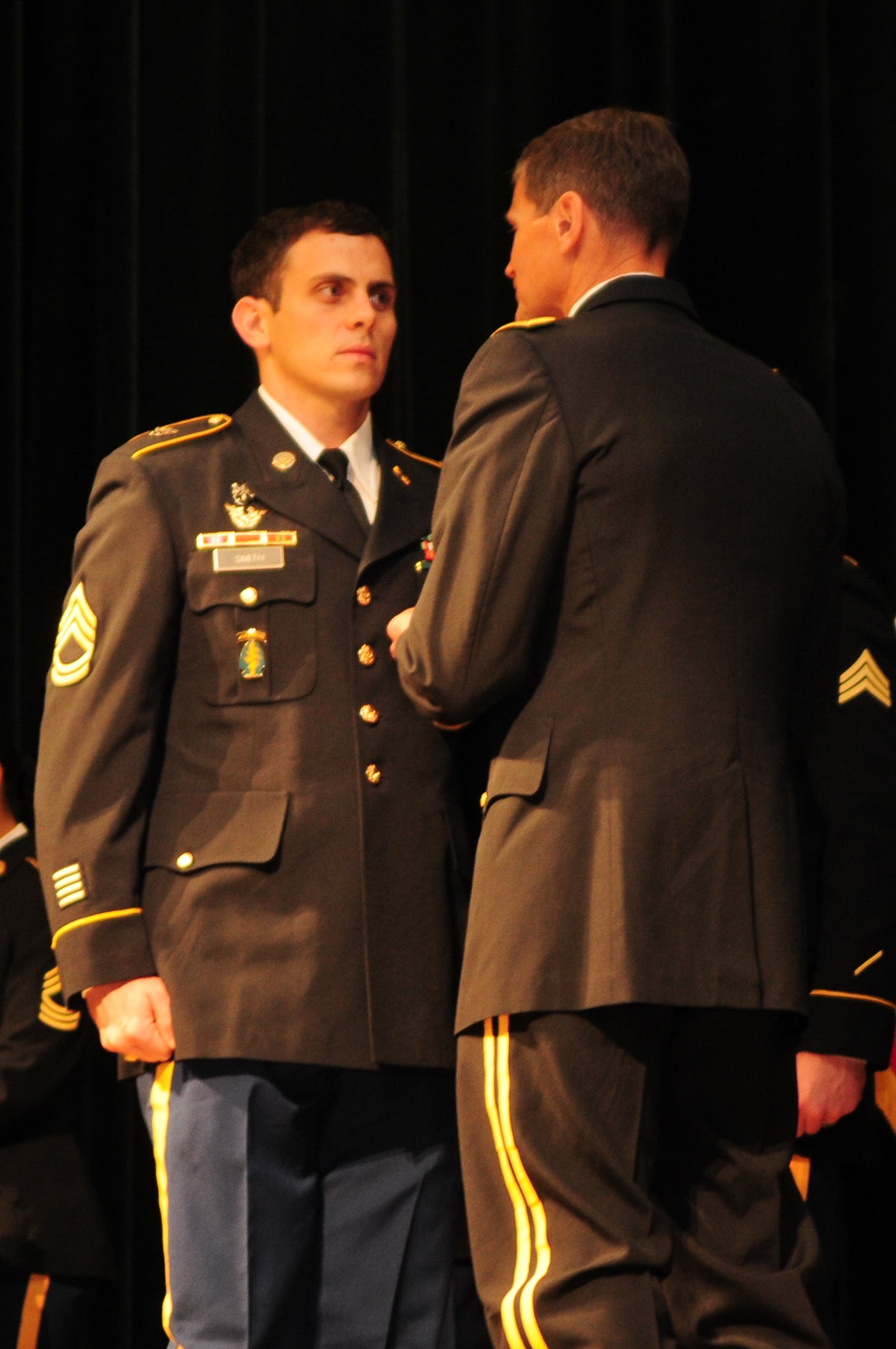
Smith
Photo Credit: 3rd Special Forces Group
• Sgt. 1st Class Keith Smith earned a Silver Star for helping fend off a January 2013 suicide attack on a base in the Shinwar district of Afghanistan's Nangarhar province. Smith "neutralized" two would-be suicide attackers, according to the narrative accompanying Smith's award citation, before they could reach their intended target: A U.S. Special Forces compound inside the base. He also took out an insurgent machine gunner who tried to enter the compound.
The actions were critical in turning the momentum of the fight, according to the narrative, giving U.S. and allied forces time to "gain fire superiority and kill an additional four insurgents" outside the main installation.
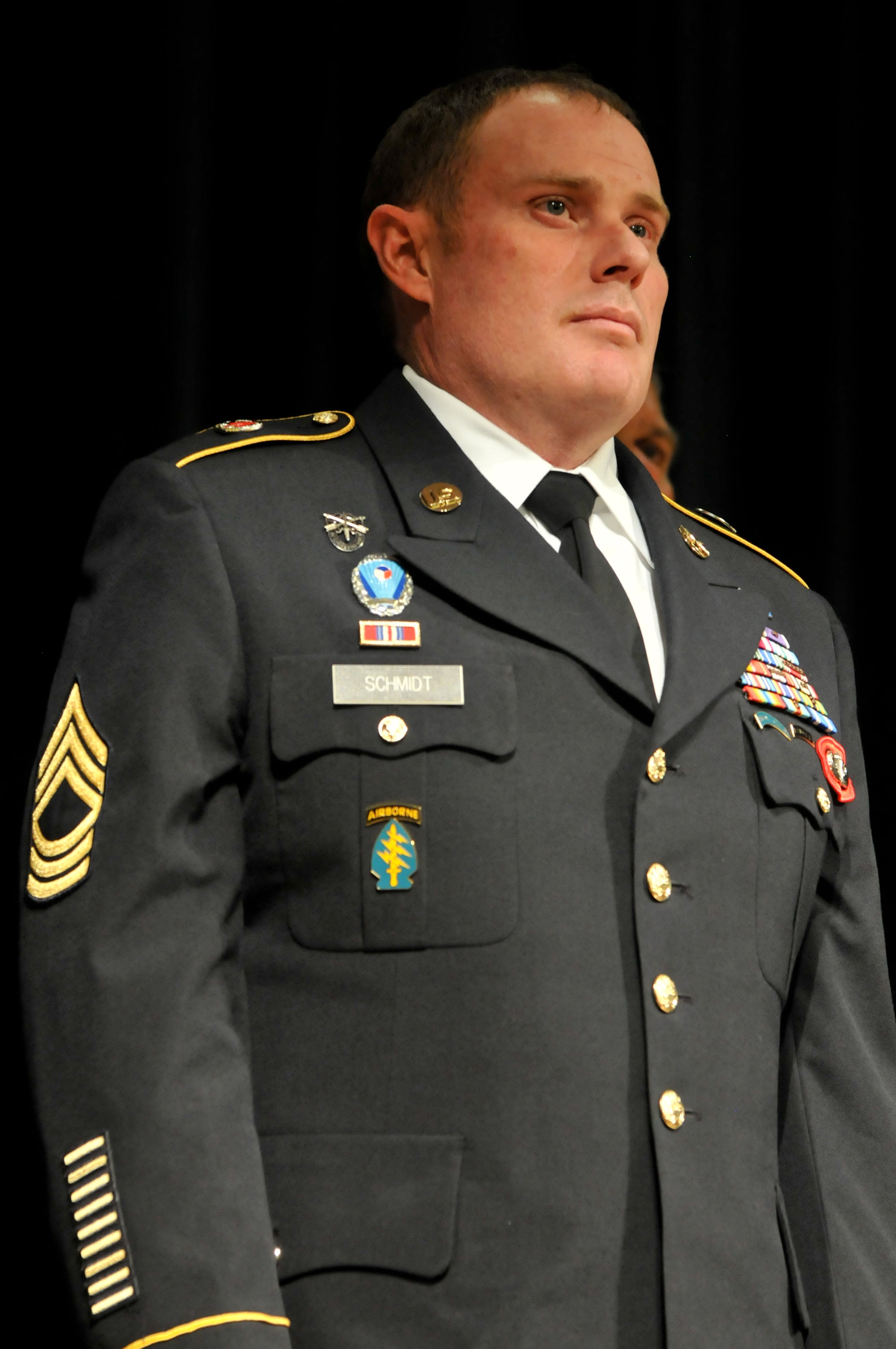
Schmidt
Photo Credit: 3rd Special Forces Group
• Master Sgt. Carl Schmidt's actions fending off a Christmas Eve insurgent attack on his patrol, most of which came after he'd been shot in the face, earned him a Silver Star.
Schmidt was with a dismounted element of his Alpha 3232 detachment on Dec. 24, 2013, at Camp New in Kabul province's Saribo District when insurgents began delivering "extremely effective" machine gun and small-arms fire, according to the narrative accompanying his award citation.
Schmidt initially returned fire, then made his way to a nearby vehicle to better coordinate his unit's response. He continued that work despite "an excessive laceration to his upper lip," the narrative states, including making a "100-meter bound" through enemy gunfire to fix one of the unit's two broken crew-served weapon systems.
His actions allowed the unit not only to repel the attack, but to provide fire support to a nearby observation post that had been targeted by the same insurgent force.
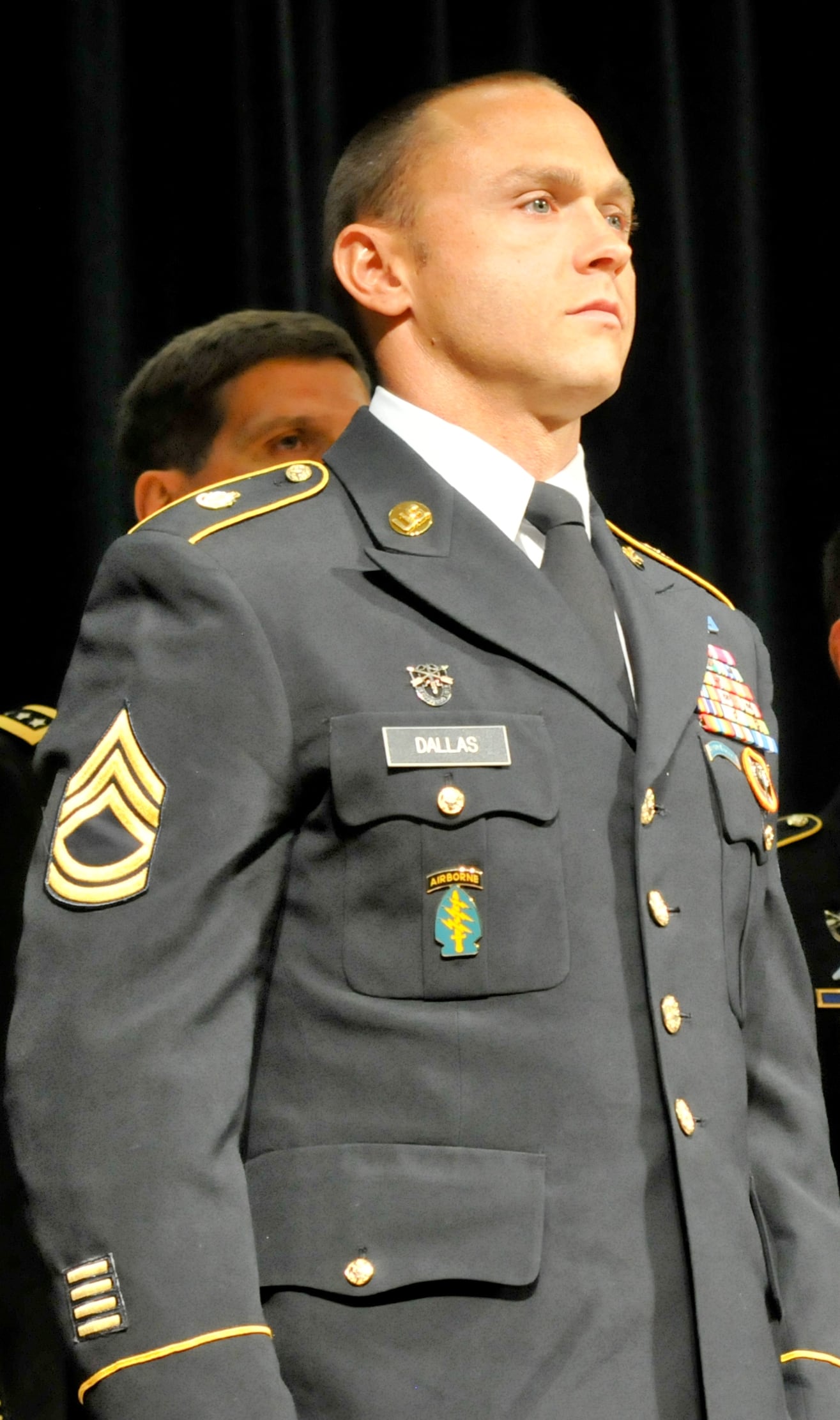
Dallas
Photo Credit: 3rd Special Forces Group
• Staff Sgt. Russell Dallas and his entire unit came under heavy mortar, small arms and RPG fire shortly after their Jan. 14, 2014, insertion into a contested region of Parwan province's Ghorband district.
Dallas earned a Silver Star for braving that fire on multiple occasions, according to the narrative accompanying his citation: First to direct team members in the face of the attack, then to provide aid to a wounded teammate, offering "all possible life saving interventions ... until all measures were exhausted."
Dallas carried the casualty from the area himself, according to the narrative.
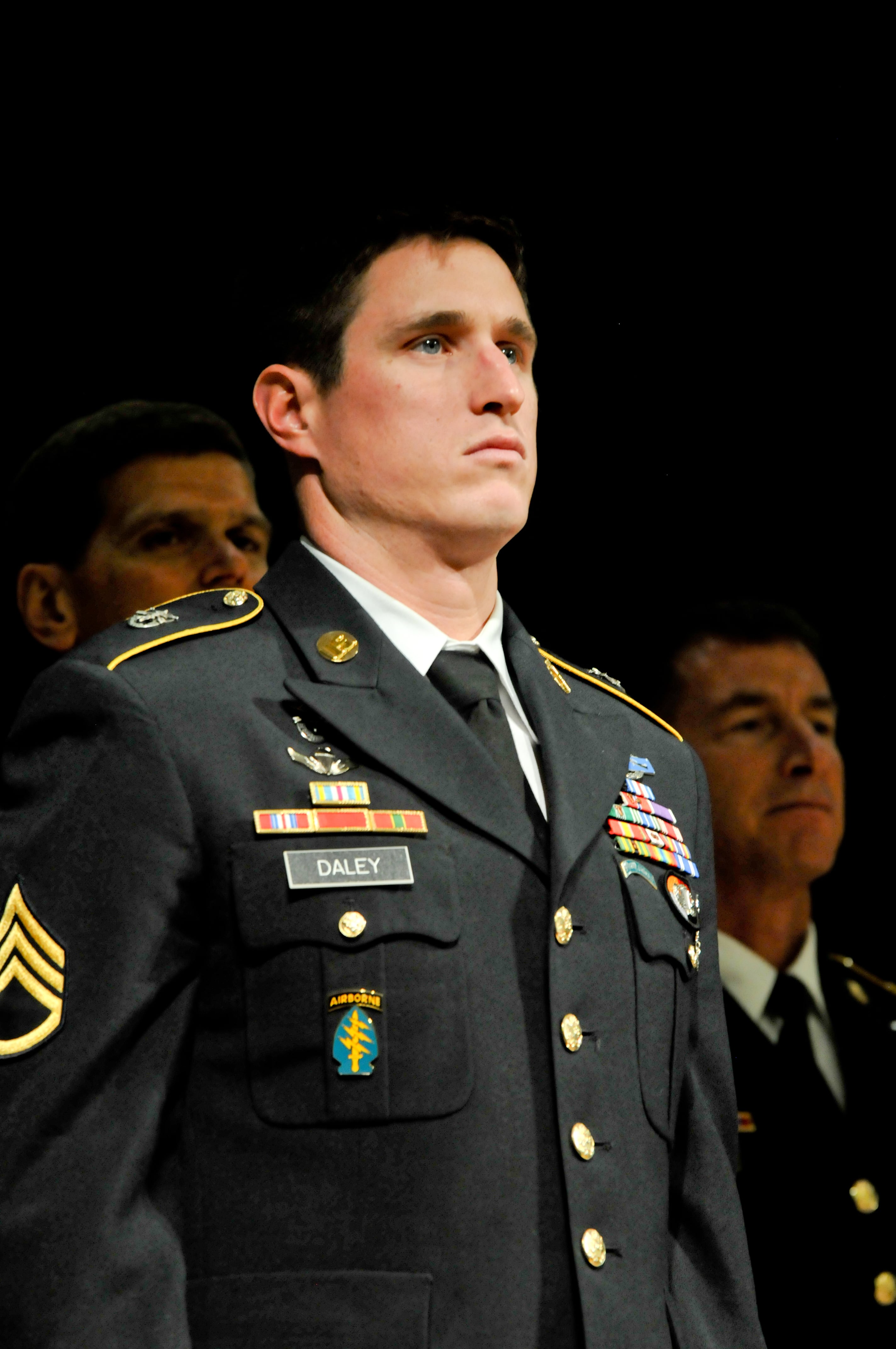
Daley
Photo Credit: 3rd Special Forces Group
• Staff Sgt. Thomas Daley earned a Silver Star for his actions on Feb. 10, 2014, on the way back to a local police station after a two-day insurgent clearance operation in a village in Kapisa province's Tagab district.
Enemy fire disabled Daley's vehicle, but he was able to escape, according to a narrative accompanying the citation. Soldiers in the group's rear vehicle weren't so lucky, taking a direct RPG hit and suffering "catastrophic wounds to their extremities."
Daley ducked fire to reach the vehicle and carry the soldiers to safety, then began coordinating an airstrike on enemy positions.
After the casualties were evacuated, Daley led a partner unit in clearing IEDs from the convoy's path, suffering a shrapnel wound to his face from a detonation in the process but refusing medical evacuation.
Kevin Lilley is the features editor of Military Times.
Michelle Tan is the editor of Army Times and Air Force Times. She has covered the military for Military Times since 2005, and has embedded with U.S. troops in Iraq, Afghanistan, Kuwait, Haiti, Gabon and the Horn of Africa.




